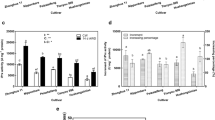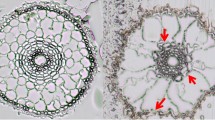Abstract
Background and aim
The molecular physiological mechanism of alternative wetting and drying (AWD) promoting iron plaque (IP) formation is unknown. Here, we report that a glycolate oxidase (GLO) gene, OsGLO4 contributes to AWD-induced IP formation.
Methods
Rice plants were grown in sand to explore the relationship among IP content, GLO activity, H2O2 concentration and OsGLO4 expression under AWD treatment.
Results
AWD significantly promoted GLO activity, OsGLO4 expression,and IP content in rice roots. Overexpressing OsGLO4 (OX) showed more 46.2% IP content than wild type (WT). Results with X-ray diffraction analysis indicated that OX also had a higher proportion of FeIII compound in IP in comparison to WT. The activity of GLO and H2O2 concentration in OX roots were 170.3% and 126.7% higher than those of WT. Interestingly, H2O2 distribution in epidermal cells was consistent with the spatial distribution of IP. Treatment with glycolic acid raised GLO activity by 88.9% and IP content by 33.3%; while α-hydroxy-2-pyridinemethanesulfonic acid inhibited GLO activity and reduced IP content. Exogenous H2O2 or treatment with aminotriazole increased the quantities of IP significantly, while dimethylthiourea reduced it.
Conclusion
OsGLO4 is involved in the formation of IP by mediating GLO activity and H2O2 production under AWD condition.







Similar content being viewed by others
Abbreviations
- AWD:
-
alternative wetting and drying
- IP:
-
iron plaque
- CF:
-
continuous flooding
- NRIP:
-
non-reddish brown iron plaque
- RIP:
-
reddish brown iron plaque
- GLO:
-
glycolate oxidase
- CAT:
-
catalase
- H2O2 :
-
hydrogen peroxide
- HPMS:
-
α-hydroxy-2-pyridinemethanesulfonic acid
- GLC:
-
glycolic acid
- AT:
-
3-amino-1,2,4-triazole
- DMTU:
-
dimethylthiourea
- DAB:
-
diaminobenzidine
- DO:
-
dissolved oxygen
- ROL:
-
radial oxygen loss
References
Ando T, Yoshida S, Nishiyama I (1983) Nature of oxidizing power of rice roots. Plant Soil 72:57–71
Armstrong W (1979) Aeration in higher plants. Adv Bot Res 7:225–232
Babuponnusami A, Muthukumar K (2014) A review on Fenton and improvements to the Fenton process for wastewater treatment. J Environ Chem Eng 2:557–572
Baxter A, Mittler R, Suzuki N (2014) ROS as key players in plant stress signalling. J Exp Bot 65:1229–1240
Ben-Noah I, Friedman SP (2016) Oxygation of clayey soils by adding hydrogen peroxide to the irrigation solution: Lysimetric experiments. Rhizosphere 2:51–61
Bradford M (1976) A rapid and sensitive method for the quantitation of microgram quantities of protein utilizing the principle of protein-dye binding. Anal Biochem 72:248–254
Carlson L, Schwertmann U (1987) Iron and manganese oxides in Finnish ground water treatment plants. Water Res 21:165–170
Chen L, Kao C (1999) Effect of excess copper on rice leaves: evidence for involvement of lipid peroxidation. Bot Bull Acad Sinica 40:283–287
Chen CC, Dixon JB, Turner FT (1980) Iron coatings on rice roots: mineralogy and quantity influencing factors. Soil Sci Soc Am J 44:635–639
Chen XP, Kong WD, He JZ, Liu WJ, Smith SE, Smith FA, Zhu YG (2008) Do water regimes affect iron plaque formation and microbial communities in the rhizosphere of paddy rice? J Plant Nutr Soil Sc 171:193–199
Claff SR, Sullivan LA, Burton ED, Bush RT (2010) A sequential extraction procedure for acid sulfate soils: partitioning of iron. Geoderma 155:224–230
Corpas FJ, Barroso JB, del Río LA (2001) Peroxisomes as a source of reactive oxygen species and nitric oxide signal molecules in plant cells. Trends Plant Sci 6:145–150
Cui LL, YS L, Li Y, Yang CW, Peng XX (2016) Overexpression of glycolate oxidase confers improved photosynthesis under high light and high temperature in rice. Front Plant Sci 7:1165
Das S, Chou ML, Jean JS, Liu CC, Yang HJ (2016) Water management impacts on arsenic behavior and rhizosphere bacterial communities and activities in a rice agro-ecosystem. Sci Total Environ 542:642–652
Esser C, Kuhn A, Groth G, Lercher MJ, Maurino VG (2014) Plant and animal glycolate oxidases have a common eukaryotic ancestor and convergently duplicated to evolve long-chain 2-hydroxy acid oxidases. Mol Biol Evol 31:1089–1101
Fu YQ, Yang XJ, Ye ZH, Shen H (2016) Identification, separation and component analysis of reddish brown and non-reddish brown iron plaque on rice (Oryza Sativa) root surface. Plant Soil 402:277–290
Fu YQ, Yu XL, Yang XJ, Shen H (2017) Gene expression profile analysis for alternate wetting and drying induced formation of iron plaque on root surface of rice seedlings. Chinese J Rice Sci 31:133–148 (in Chinese)
Hall NP, Reggiani R, Lea PJ (1985) Molecular weights of glycollate oxidase from C3 and C4 plants determined during early stages of purification. Phytochemistry 24:1645–1648
Hansel CM, Fendorf S, Sutton S, Newville M (2001) Characterization of Fe plaque and associated metals on the roots of mine-waste impacted aquatic plants. Environ Sci Technol 35:3863–3868
Havir EA (1992) The in vivo and in vitro inhibition of catalase from leaves of Nicotiana Sylvestris by 3-amino-1, 2, 4-triazole. Plant Physiol 99:533–537
Jenkins C, Rogers LJ, Kerr MW (1982) Glycollate oxidase inhibition and its effect on photosynthesis and pigment formation in Hordeum Vulgare. Phytochemistry 21:1849–1858
Kangasjärvi S, Neukermans J, Li S, Aro EM, Noctor G (2012) Photosynthesis, photorespiration, and light signalling in defence responses. J Exp Bot 63:1619–1636
Liu WJ, Zhu YG, Hu Y, Williams PN, Gault AG, Meharg AA, Charnock JM, Smith FA (2006) Arsenic sequestration in iron plaque, its accumulation and speciation in mature rice plants (Oryza sativa L.) Environ Sci Technol 40:5730–5736
Lu SY, Su W, Li HH, Guo ZF (2009) Abscisic acid improves drought tolerance of triploid bermudagrass and involves H2O2 and NO induced antioxidant enzyme activities. Plant Physiol Bioch 47:132–138
Mendelssohn IA, Kleiss BA, Wakeley JS (1995) Factors controlling the formation of oxidized root channels: a review. Wetlands 15:37–46
Noctor G, Gomez L, Vanacker H, Foyer CH (2002) Interactions between biosynthesis, compartmentation and transport in the control of glutathione homeostasis and signaling. J Exp Bot 53:1283–1304
Pereira EG, Oliva MA, Siqueira-Silva AI, Rosado-Souza L, Pinheiro DT, Almeida AM (2014) Tropical rice cultivars from lowland and upland cropping systems differ in iron plaque formation. J Plant Nutr 37:1373–1394
Price AH, Norton GJ, Salt DE, Ebenhoeh O, Meharg AA, Meharg C, Islam MR, Sarma RN, Dasgupta T, Ismail AM (2013) Alternate wetting and drying irrigation for rice in Bangladesh: is it sustainable and has plant breeding something to offer? Food Energy Secur 2:120–129
Santos A, Rodríguez S, Pardo F, Romero A (2016) Use of Fenton reagent combined with humic acids for the removal of PFOA from contaminated water. Sci Total Environ 563:657–663
Talbi S, Romero-Puertas MC, Hernández A, Terrón L, Ferchichi A, Sandalio LM (2015) Drought tolerance in a Saharian plant Oudneya africana: role of antioxidant defences. Environ Exp Bot 111:114–126
Taylor GJ, Crowder AA (1983) Use of the DCB technique for extraction of hydrous iron oxides from roots of wetland plants. Am J Bot 70:1254–1257
Thordal-Christensen H, Zhang ZG, Wei YD, Collinge DB (1997) Subcellular localization of H2O2 in plants. H2O2 accumulation in papillae and hypersensitive response during the barley-powdery mildew interaction. Plant J 11:1187–1194
Tripathi RD, Tripathi P, Dwivedi S, Kumar A, Mishra A, Chauhan PS, Norton GJ, Nautiyal CS (2014) Roles for root iron plaque in sequestration and uptake of heavy metals and metalloids in aquatic and wetland plants. Metallomics 6:1789–1800
Wu C, Ye ZH, Hui L, SC W, Dan D, Zhu YG, Wong MH (2012) Do radial oxygen loss and external aeration affect iron plaque formation and arsenic accumulation and speciation in rice? J Exp Bot 63:2961–2970
Xiao WD, Ye XZ, Yang XE, Li TQ, Zhao SP, Zhang Q (2015) Effects of alternating wetting and drying versus continuous flooding on chromium fate in paddy soils. Ecotox Environ Safe 113:439–445
Xu B, Yu S (2013) Root iron plaque formation and characteristics under N2 flushing and its effects on translocation of Zn and cd in paddy rice seedlings (Oryza sativa). Ann Bot-London 111:1189–1195
Yan DF, Ma W, Song XJ, Bao YY (2017) The effect of iron plaque on uptake and translocation of norfloxacin in rice seedlings grown in paddy soil. Environ Sci Pollut R. https://doi.org/10.1007/s11356-017-8368-z
Yang JX, Tam NFY, Ye ZH (2014) Root porosity, radial oxygen loss and iron plaque on roots of wetland plants in relation to zinc tolerance and accumulation. Plant Soil 374:815–828
Yoshida S, Douglas A, Forno JC (1976) Laboratory manual for physiological studies of Rice. IRRI, Los Banos
Zelitch I (1973) Plant productivity and the control of photorespiration. Proc Nat Acad Sci 70:579–584
Zhang H, Xue YG, Wang ZQ, Yang JC, Zhang JH (2009) An alternate wetting and moderate soil drying regime improves root and shoot growth in rice. Crop Sci 49:2246–2260
Zhang ZS, YS L, Zhai LG, Deng RS, Jiang J, Li Y, He ZH, Peng XX (2012) Glycolate oxidase isozymes are coordinately controlled by GLO1 and GLO4 in rice. PLoS One 7:e39658
Zhang ZS, YY X, Xie ZW, Li XY, He ZH, Peng XX (2016) Association-dissociation of glycolate oxidase with catalase in rice: a potential switch to modulate intracellular H2O2 levels. Mol Plant 9:737–748
Zhong C, Cao XC, Zhu LF, Zhang JH, Yu SM, Jin QY (2016) A review on effects and regulation of paddy alternate wetting and drying on rice nitrogen use efficiency. Trans Chinese Soc Agr Eng 32:139–147
Acknowledgements
We thank Professor Xinxiang Peng (South China Agricultural University) for assisting with OsGLO4 overexpression lines seeds. This work was supported by National Natural Science Foundation of China (grant no. 31372125).
Author information
Authors and Affiliations
Corresponding author
Additional information
Responsible Editor: Michael A. Grusak.
Rights and permissions
About this article
Cite this article
Yu, XL., Wu, DM., Fu, YQ. et al. OsGLO4 is involved in the formation of iron plaques on surface of rice roots grown under alternative wetting and drying condition. Plant Soil 423, 111–123 (2018). https://doi.org/10.1007/s11104-017-3493-5
Received:
Accepted:
Published:
Issue Date:
DOI: https://doi.org/10.1007/s11104-017-3493-5




